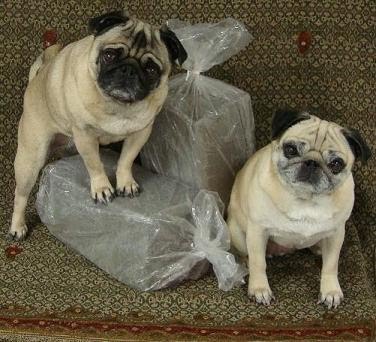As artists make art, they eventually go to shows and conventions. We take our Pugs with us to our various trade shows. When they see the suitcase, they start squealing and singing with joy; when the crates are packed, the excitement is ear-splitting. There is a specific scream they reserve for the five minutes of loading, up to the highway onramp: "Weee go! GO! GO!" This scream is punctuated with "I ruv yooooooo!", just so we know they love us extra, for this. The hum of the freeway under the tires lulls them to sleep, and they only rouse when the car slows to an offramp. Here we just got on the freeway:

They know that they will soon be in a sea of people that (they think) are there to pet them. Attention is, of course, high on the Pug list of daily requirements.
How does one mesh a live Pug into a crowded event where delicate expensive things are on display? One word: homework.


They know that they will soon be in a sea of people that (they think) are there to pet them. Attention is, of course, high on the Pug list of daily requirements.
How does one mesh a live Pug into a crowded event where delicate expensive things are on display? One word: homework.

I read the event's rules, the hotel rules, and make sure the kennel cough vax are boosted within the past six months. (Annual is OK for dogs who don't travel.) I also drill commands a day or two before leaving, using food rewards and creating novel situations at home. For example, on a warm day, I will put a wet towel on the kitchen floor and direct the Pugs to sit and lay down on it. Things at shows may be new and strange, so it's good to review commands for a few minutes, and make sure your Pugs are easy to manage in any situation. It is also important to be a good citizen and clean up after your dog; we pack those handy belt-loop baggie dispensers. We don't put our dogs up on foodservice counters or on lobby furnishings because it's unsanitary, impolite, and some people may be allergic to any residual hairs or dander. Good manners of both dog and owner are essential to being welcomed back again.
We start our Pugs at trade shows as soon as each one joins our family. Our Pugs are now known by name to the staff at some shows. The sights, sounds, and smells of a convention are excellent preparation for a puppy who will be competing at dog shows. Here is our Little Man at a scifi convention last year:

The Pugs are excellent conversation starters, and always make people smile. They also keep our spirits up, no matter the outcome of a competition or sale. If sales are slow, the Pugs will clown for us until we laugh. When business is bustling, they quietly snooze in their box under the table and wait for closing time.
We start our Pugs at trade shows as soon as each one joins our family. Our Pugs are now known by name to the staff at some shows. The sights, sounds, and smells of a convention are excellent preparation for a puppy who will be competing at dog shows. Here is our Little Man at a scifi convention last year:

The Pugs are excellent conversation starters, and always make people smile. They also keep our spirits up, no matter the outcome of a competition or sale. If sales are slow, the Pugs will clown for us until we laugh. When business is bustling, they quietly snooze in their box under the table and wait for closing time.



